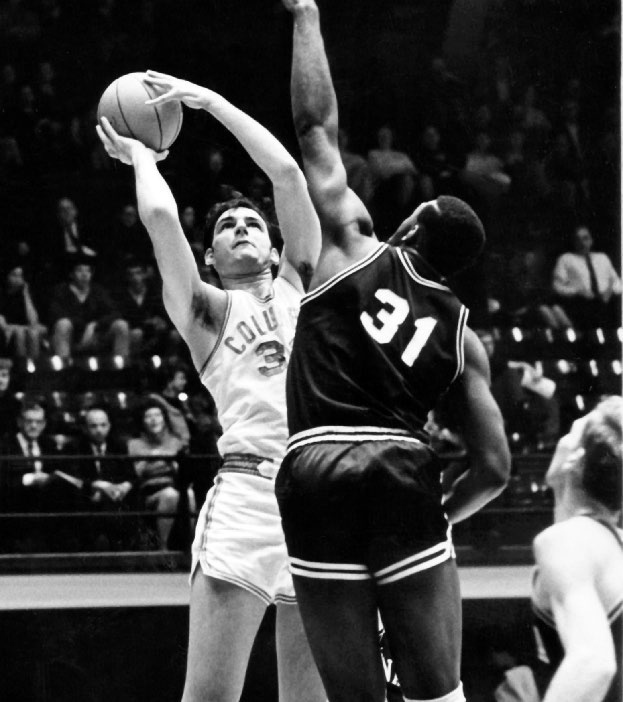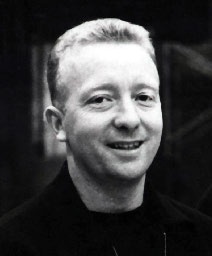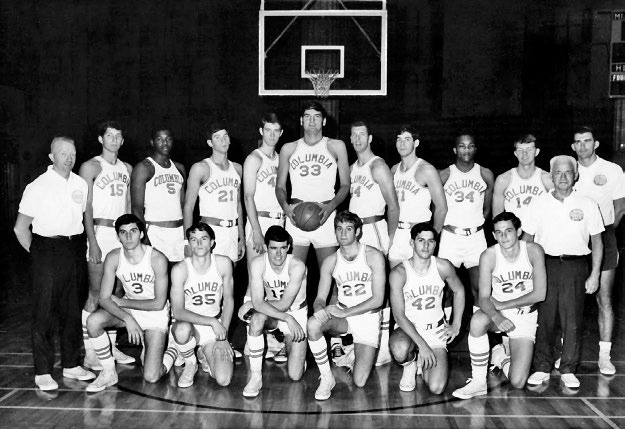
Dave Newmark ’68 shoots against future Basketball Hall of Famer Bob Lanier of St. Bonaventure in the NCAA Tournament
Fifty years ago, the Lions were kings of Ivy basketball
In a country that was becoming increasingly divided by a war on the far side of the globe, on a campus that would soon erupt in unprecedented chaos, one group brought the Columbia community together in early 1968: the Lions basketball team, which won the Ivy League championship for the first time in school history by beating Princeton in a one-game playoff.
“The spring of 1968 was a dramatic time in our country,” recalls Jonathan D. Schiller ’69, LAW’73, a reserve forward who played regularly on that team and who is now a prominent attorney and chair of Columbia’s Board of Trustees. “In our race to the championship, everyone tried to attend our games regardless of politics or degree of activism. It was a thrill to have everybody’s support. It was fast becoming a very difficult time on campus, but it was great to have this unity in a dysfunctional time.”
Since the Ivy League began men’s basketball competition in 1956–57, the 1967–68 team holds the distinction of having won Columbia’s only men’s basketball Ivy League championship. It’s something that the members of the team don’t necessarily dwell on, but in which they nonetheless take great pride.
“I try not to let it be one of the high points of my life, because you don’t want to be one of those ex-athletes who is living in the past. And yet, it is something I’m very proud of,” says Larry Borger ’68, the team’s 6-foot-6-inch captain and sixth man, who had careers as an educator and corporate trainer before retiring in 2003 from a Phoenix utility company. “Every now and then I’ll bump into someone who asks me if I played basketball, and if I find out they played collegiately, I’ll weave in a little braggadocio about our championship.”
“You don’t really reflect on what happened until years later,” says Roger Walaszek ’69, LAW’73, a starting forward on that team who became an attorney in western Massachusetts. “It was a tremendous year.”
The star of the Lions was Jim McMillian ’70, a 6-foot-5-inch forward who went on to play nine NBA seasons and won a championship with the 1971–72 Los Angeles Lakers. He led the Columbia team with 22.3 ppg and earned the first of three consecutive All-Ivy first team honors. Walaszek recalls McMillian as “an incredibly talented athlete, a great shooter and team player with great basketball instincts.” Borger agrees, “A great team player, on and off the court — we all liked him.”
Joining McMillian on the All-Ivy first team (and several All-America teams as well) was 7-foot center Dave Newmark ’68, a presence in the pivot with a feathery jump shot. Walaszek earned All-Ivy second team honors as did Heyward Dotson ’70, LAW’76, a solid all-around guard who would win a Rhodes Scholarship. Rounding out the starting five was point guard Billy Ames ’68, who was backed up at the playmaker spot by Bruce Metz SEAS’69. Columbia was coached by Jack Rohan ’53, a fine tactician who is the school’s all-time leader with 198 wins in two stints as head coach, 1961–74 and 1990–95.
Columbia at the time played its home games in University Hall, now known as the Blue Gym, a band box with a seating capacity of 1,754 (the year Columbia was founded, presumably no coincidence). Its eccentricities included two huge tiled pillars at courtside between the teams’ benches and an overhead running track that often was used by fans for standing room. By midseason every game was sold out, with students often lining up for hours to get tickets. The band was a boisterous presence at every game, and their songs and the fans’ cheers reverberated in the confined quarters, providing the Lions with a solid home-court advantage — Columbia’s home record was a perfect 12–0.
“I can’t say enough about the tremendous support we received,” says Walaszek. “People were caught up with the team the entire year — not just sports fans but also other students, faculty, the entire academic community.”
After cruising past their first four opponents, the Lions suffered successive losses to Cornell, Georgetown and Fordham and went into the Holiday Festival at Madison Square Garden — then the premier midseason tournament in the country — with a 4–3 record. Columbia, just 11–14 the previous season, had a revamped lineup built around two sophomores, McMillian and Dotson, who were playing their first season of varsity ball (freshmen were ineligible at the time), and Newmark, who was returning after a year’s leave of absence for health reasons.
“We were a very young team and it took us a little while to gel,” says Walaszek. “That tournament brought us together as a team. That was the turning point. We went from nowhere to a place in the top 10 national rankings.”
The Lions did so by beating national powers West Virginia 98–71, Louisville 74–67 and St. John’s 60–55 in a span of five days between Christmas and New Year’s. The victory over Louisville was particularly impressive, as the Cardinals featured All-Americans Wes Unseld and Butch Beard and were expected to contend for the national championship.
“That was an unbelievable experience,” says Schiller. “After we beat nationally ranked Louisville, we rode the IRT back to campus with the band and they played ‘Who Owns New York?’ the whole way. It was the greatest subway ride in history.”
The Lions returned to Ivy League play on January 5 with a 100–72 thumping of Yale and did not lose again until the season finale on March 2, a 68–57 defeat at Princeton that left the Lions and Tigers tied atop the Ivy League with 12–2 records. That forced a one-game playoff for the Ivy title and a berth in the NCAA tournament. The game was to be played on March 5 at a neutral site, and to the delight of Columbia supporters, the site chosen by the Ivy League was
St. John’s University Alumni Hall in Queens, N.Y.
“The Columbia fans got there hours before the game and were a great help in motivating us,” says Walaszek. “It was pretty incredible. It was just like a home game.” Indeed, the game story in Spectator noted that the attendance was a capacity 6,005, “most of them Columbia partisans.”
Newmark, who had missed the final four games of the season with a severely sprained ankle and was considered doubtful for the playoff, managed to play and scored the first basket of the game on a drive to the hoop that sparked Columbia to a quick early lead. The Lions never looked back, taking a 41–33 margin into halftime and extending it to double digits by outscoring Princeton 13–7 to start the second half en route to a 92–74 victory. McMillian was at his best, leading all scorers with 37 points. Walaszek added 20 and Dotson contributed 19 plus outstanding defense against Princeton’s star guard, Geoff Petrie.
When the team bus got back to campus, says Borger, “I remember there being a whole bunch of people out there celebrating. They celebrated long into the night.”
Columbia went on to defeat LaSalle 83–69 in the first round of the NCAA tournament before suffering a 61–59 overtime loss to Davidson on March 15 at Raleigh, N.C., in what was then the round of 16. They finished the season with a 23–5 record after beating St. Bonaventure and their All-American center, Bob Lanier, 95–75 in the consolation game.
Rohan’s contributions in shaping the team’s success cannot be overstated. The Lions’ played an aggressive pressing defense and an offense that stressed ball movement and teamwork to produce open shots. “Basketball is designed to be played by five people who play together and work hard to get the best shot, and that’s the way we played under Jack Rohan,” says Walaszek. “He was a taskmaster, but that’s why he was a great coach, the NCAA Coach of the Year. Execution was his strength and that’s what he drilled in us.”
“After we beat nationally ranked Louisville, we rode the IRT back to campus with the band and they played ‘Who Owns New York?’ the whole way. It was the greatest subway ride in history.” — Jonathan D. Schiller ’69, LAW’73
Schiller, who describes that squad as “a very intelligent team,” recalls how Rohan had the 1968–69 team, which was headed to Hawaii to play in the Rainbow Classic, stop in Los Angeles to attend a UCLA practice under legendary coach John Wooden. “He modeled our press on the UCLA press and he wanted us to have that experience of seeing firsthand how Coach Wooden taught discipline and movement to his team.”
Rohan died in 2004 and McMillian in 2016. The Athletics Department is planning a reunion for the team — the first to be inducted into the Columbia University Athletics Hall of Fame, in 2006 — to be held the weekend of February 2–3.




